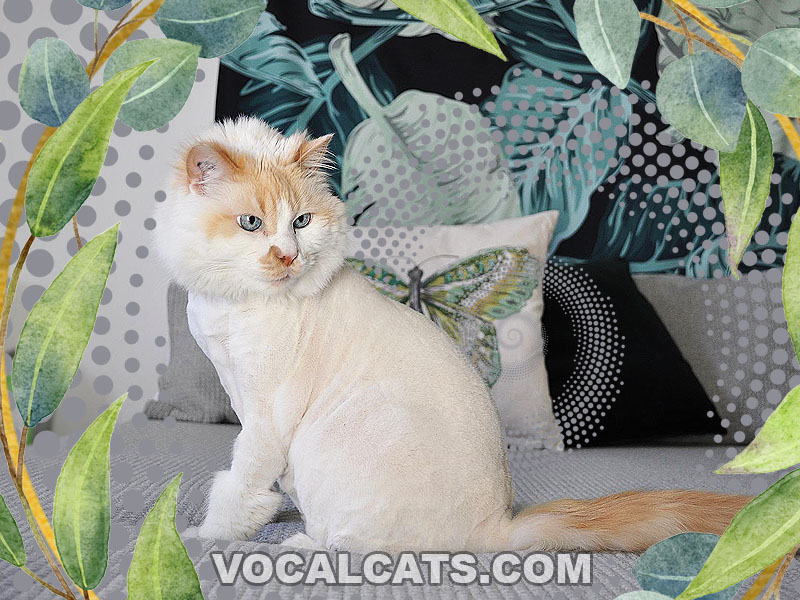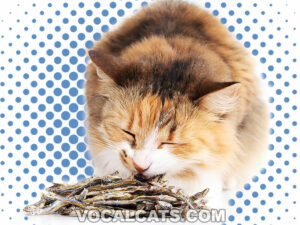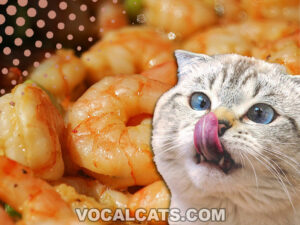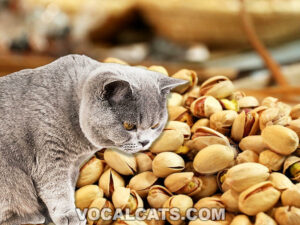When it comes to Orange cats, the animated character Garfield always comes to mind. But, did you know that Ragdolls can also have this adorable color in their points?
A red or cream Ragdoll is always described as an Orange Ragdoll Cat because of the red-yellowish shade they possess. No matter what color you prefer to call them, whether Cream or Red Ragdoll Cat, they are still an adorable and gentle cat breed.
In this comprehensive guide, we will discuss everything you need to know about the Orange Ragdoll, including the various Orange Ragdoll coat pattern, common health issues, grooming and dietary requirements, ideal living conditions, and more. If you’re still interested in the Orange Rag Doll Cat after reading this guide, we’ve provided a list of breeders you can reach out to. So keep reading to learn more!
Contents
- Orange Ragdoll Cat: Breed overview
- Can a Ragdoll cat be Orange?
- What is an Orange Ragdoll Cat?
- What is a Ginger Ragdoll called?
- Orange Ragdoll genetics
- Are Orange Ragdolls rare?
- Is Orange a recognized Ragdoll Cat color?
- Orange Ragdoll Cat physical appearance
- Various Orange Rag Doll Cat colors and patterns
- Orange Ragdoll Cat size, height, and weight
- Orange Ragdoll cat personality and temperament
- Do Orange Ragdoll Cats make good family pets?
- Ragdoll cat Orange training
- Orange Ragdoll exercise requirement
- Orange Ragdoll Cat grooming and cleaning
- Orange Ragdoll food and diet
- Orange Ragdoll Cat health issues
- Orange Ragdoll Cat lifespan
- Orange Ragdoll Cat breeders
- Orange Ragdoll kitten
- Orange Ragdoll cat price
- Places to find Orange Ragdoll kittens for sale
- Finding a healthy Orange Ragdoll cat for sale
- Orange Ragdoll Cat Mix
- Orange Ragdoll Cat: Pros and Cons
- Is the Orange Ragdoll Cat right for me?
- Related Questions
Orange Ragdoll Cat: Breed overview
Below are some brief facts and breed traits of the Orange Ragdoll.
| Other names | Red Ragdoll cat, Flame Point Ragdoll, Ginger Ragdoll Cat |
| Size | Large |
| Weight | 8 – 20 pounds |
| Height | 9 – 11 inches |
| Coat Colors | Orange, Red, Cream, White |
| Child Friendliness | High |
| Feline Friendliness | High |
| Training Difficulty | Moderate |
| Grooming Upkeep | Moderate – High |
| Exercise Needs | Low- Moderate |
| Health | Moderate |
| Lifespan | 12 – 16 years |
| Kitty Costs | $1,000 – $2,000 |
Can a Ragdoll cat be Orange?
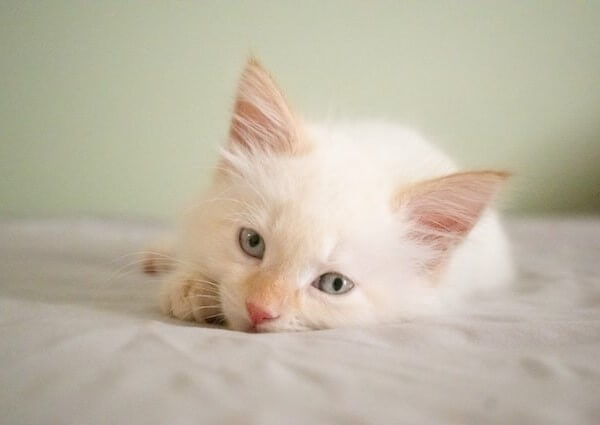
Yes, a Ragdoll cat can have Orange-colored points, which is caused by a gene that controls the red pigmentation, called pheomelanin. The degree of pheomelanin pigmentation can range from pale creamy apricot to brownish-red.
What is an Orange Ragdoll Cat?
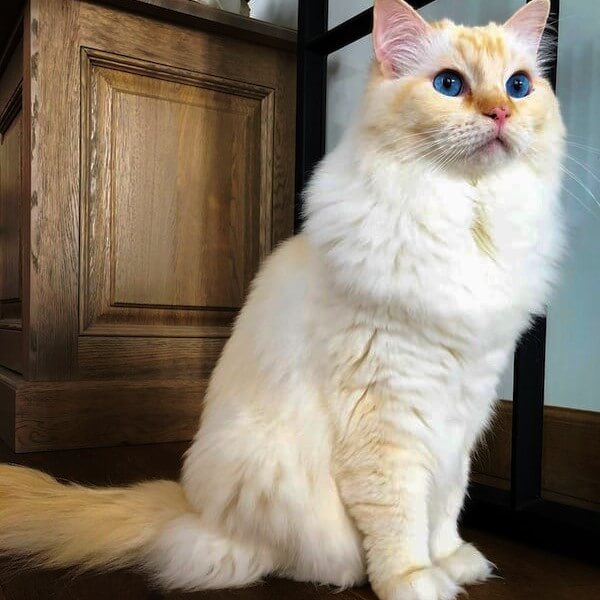
Orange Ragdoll Cat is a Ragdoll with a light apricot to red-Orange points on the face, ears, legs, and tail.
We can separate them into four (4) groups to make them easier to understand:
- Cream Ragdoll with solid points, which is either Colorpoint, Mitted, or Bicolor.
- Red Ragdoll with solid points in either Colorpoint, Mitted, or Bicolor.
- Red Lynx Ragdolls with deep red bars of ghost striping or ticking on the points.
- Cream Lynx Ragdolls with very light brown bars of ghost striping or ticking on the points.
Tortoiseshell or Tortie Ragdolls cannot be considered Orange Ragdolls since they have the additional brown or seal color in their coat.
What is a Ginger Ragdoll called?
A Ginger Ragdoll is also called a Flame Point Ragdoll. The terms Orange, red, ginger, and flame are often interchanged by cat aficionados, but they all refer to the color red albeit in different intensities.
Orange Ragdoll genetics
The gene responsible for the Orange-red color or pheomelanin can be represented by the dominant ‘O’ gene. Genes responsible for color are always attached to the ‘X’ chromosome.
Since males have XY chromosomes, they only need one set of instructions for color pigmentation, which in the case of an Orange-colored Ragdoll, the dominant ‘O’ will attach itself to the X-chromosome.
This makes most Orange-colored cats male. Male Orange cats outnumber females Orange cats by as much as a 3:1 ratio.
For females to be Orange, they need to carry the dominant ‘O’ in each of the X-chromosome. If only one X-chromosomes carries it, then the female may turn out as a Calico Ragdoll or tortoiseshell.
Are Orange Ragdolls rare?
No, Orange Ragdolls are not rare although they are uncommon. Additionally, finding a female Orange Ragdoll may be tougher than you think because of the reason discussed above.
The rarest color of the Ragdoll is the Lilac, while the most common and popular is the Seal.
DON’T MISS: Seal Point Ragdoll (Complete Guide)
Is Orange a recognized Ragdoll Cat color?
Yes, Orange is a recognized color of the Ragdoll. The two (2) Orange-based colors of the Ragdoll are red and cream and both are traditional colors of the Ragdoll aside from seal, chocolate, blue and lilac.
RECOMMENDED: Blue Ragdoll Cat (Complete Guide)
Orange Ragdoll Cat physical appearance
Ragdoll Orange Cat has the same physical characteristics as all Ragdolls except for their pigmentation. They are characterized by their medium-length fur, blue eyes, and distinct color points in the extremities.
The Ragdoll body is long and rectangular with broad chests and long tails. They have long, heavily boned legs with the back legs slightly lengthier.
They also have a broad head that is equal on all sides as measured from the base of the ear to the muzzle. Ears are widely set on the head with rounded tips. The eyes are large and oval-shaped with a slight slant.
The coat of an Orange fluffy Ragdoll Cat is medium in length and made up mostly of guard hairs with little to no undercoat.
You may be interested in: Blue Eyed White Ragdoll (Complete Guide)
Various Orange Rag Doll Cat colors and patterns
Orange Ragdolls can either have red-Orange or cream points on the face, ears, legs, and tail.
The points may appear solid, but they are usually in a tabby pattern when inspected more closely. Orange tabby Ragdoll Cat has ghost striping or ticking of light and dark colors with the light colors being barely visible.
CHECK OUT: Ragdoll Tabby Mix (Complete Guide)
The possible color patterns of the Orange Ragdoll Cat are as follows:
- Red Colorpoint: Points in the ears, face, legs, and tail are apricot to red with a white body coat and some shading of red.
- Red Mitted: Same as colorpoint except there is white fur on the paws. The chin is also white that extends to the belly. Some will exhibit a white blaze on the nose or forehead.
- Red Bicolor: Points are found on the ears, tail, and face which is interrupted with a white inverted ‘V’ shape. There is also red shading on the back called a ‘saddle.’
- Cream Colorpoint: Points same as the Red Colorpoint but with a pale cream to pink tone.
- Cream Mitted
- Cream Bicolor
- Red Lynx: Points have deep red and light red striping or ticking.
- Cream Lynx: Points have striping or ticking of light pink and whitish-cream bars.
You may also like: Cream Point Ragdoll (Complete Guide)
Orange and white Ragdoll Cat
Ragdoll cat Orange and white have warm apricot points at the face, ears, legs, and tail with body coat that is creamy white. The nose leather and paw pads of a white and Orange Ragdoll Cat are coral pinks in tone.
ALSO READ: White Ragdoll Cat (Complete Guide)
Orange Ragdoll Cat size, height, and weight
An Orange full grown Ragdoll Cat will reach its full maturity by 3 to 4 years of age. Ragdolls, in general, grow in spurts during their development years and reach maturity much slower than other cat breeds.
Here is the size, height, and weight of your typical Orange Ragdoll Cat:
| Height | Weight | Length | |
| Male | 9 – 11 inches | 12 – 20 pounds | 17 – 21 inches |
| Female | 7 – 9 inches | 8 – 15 pounds | 17 – 19 inches |
Orange Ragdoll cat personality and temperament
Ragdolls are known for their puppy-like qualities having a mild temperament and a calm and gentle personality.
This is also true for Orange Ragdoll cats, although some research suggests that they are more extroverted than the differently colored Ragdolls. Some studies also posit that male Orange cats in general are more friendly, active, and devoted to their owners.
But, whatever color or pattern he is, the Ragdoll cat likes to stay close to his family members and exhibits more dependence than other cat breeds for his survival. He enjoys interaction with his family and love to be held and cuddled most of the time.
Ragdolls are also different for wanting to stay low on the ground, giving them the moniker “floor cats.” They do not have the typical behavior of other cats that like to perch on a high ground where they could survey their surroundings for any possible prey and danger.
Do Orange Ragdoll Cats make good family pets?
Yes, Orange Ragdoll Cats are a great addition to any family, especially for first-time cat owners. They love following their owners around and show great love and affection. They are gentle and playful with kids and exhibit no aggression whatsoever even toward other cats and pets.
Ragdoll cat Orange training
Ragdolls are very obedient and can easily be trained, not just litter box training or basic commands, but also certain cat tricks. The thing to remember is to use cat treats when training your Ragdoll to keep them motivated.
Giving them other positive reinforcements, such as stroking them behind the ears or petting their body, will go a long way in letting them know that their actions are appreciated.
Keeping the training sessions short and sweet will also keep them from getting bored.
Orange Ragdoll exercise requirement
What is so great about Ragdoll cats Orange is that they require minimal exercise every day and prefer lounging around the house most of the time.
But, of course, you should give them at least 15 to 20 minutes of play, whether it is playing with balls or a game of fetch, to keep them physically fit and to avoid feline obesity.
Orange Ragdoll Cat grooming and cleaning
Part of owning an Orange Ragdoll cat is grooming his long and thick fur. This means combing or brushing her fur as frequently as you can.
If you don’t do that, her fur can get matted and unsightly which may even require you to go to a grooming salon, and we know this is very expensive.
To prevent that scenario, try using a Furminator de-shedding comb. Many professional cat groomers recommend using this tool because of its effectiveness in removing about 90% of loose hair.
Another essential part of grooming is to give him a nice, warm bath at least once a month using a gentle cat shampoo.
Also, don’t skip his oral care and hygiene. Be sure to brush his teeth using an enzymatic toothpaste for healthy gums and teeth.
| Grooming Needs | Grooming Frequency |
| Hair Brushing | 3 – 4x weekly |
| Nail Trimming | As needed |
| Teeth Brushing | 2 -3x weekly |
| Bathing | Once a month |
| Eye Care | Check weekly |
| Ear Care | Check weekly |
Orange Ragdoll food and diet
Wet or canned cat food is the ideal feline food because it has a higher amount of moisture. Give him about ½ cup to ¾ cup, divided into 2 portions.
To make his food more appetizing, try interchanging the protein source like fish, chicken, beef, or lamb every other month or every few months.
Orange Ragdoll Cat health issues
One of the health issues among Orange Ragdoll cats is their predisposition to genetic diseases such as these five (5):
1. Hip Dysplasia
Hip dysplasia is an orthopedic condition that is a result of misalignment in the hip joint area. Avoiding the stairs and lameness are two of the signs.
2. Kidney Disease
There is a high chance that a Ragdoll will inherit some kidney diseases including Polycystic kidney disease which is characterized by having small tumors in the kidneys that grow with age.
3. Heart Disease
An estimated 30% of Ragdolls have genetic mutations that would most likely lead to the thickening of the heart muscles, a condition referred to as hypertrophic cardiomyopathy.
4. Gastrointestinal Disease
Ragdolls are known to have a sensitive digestive system which makes them prone to diarrhea, inflammatory bowel disease, and celiac disease.
5. Eye Disease
Genetics plays a major role in the development of eye problems in Ragdolls, including having cross eyes. Apart from that, some of them may also inherit progressive retinal atrophy which can lead to blindness and cataracts.
Orange Ragdoll Cat lifespan
How long do Orange Ragdoll cats live is one of the questions many cat owners will ask. Given the right and proper care, an Orange Ragdoll can live from 12 to 16 years.
Orange Ragdoll Cat breeders
Always practice caution when looking for Orange Ragdoll breeders. Some of them may only be after your money. So, to be sure that you are getting your money’s worth, here are the qualifications of a reputable Orange Ragdoll breeder:
- They show proof of health through DNA testing and negative test genetic results on issues like polycystic kidney problems.
- They have websites where buyers can learn more about them such as breeding practices, awards, how they raise their cats and kittens, and clients’ reviews.
- They should be active members of cat associations.
Orange Ragdoll kitten
Orange Ragdoll kittens should be weaned from their moms at around 12 weeks of age. By that time, the Ragdoll kittens Orange are already properly developed, both socially and physically.
Upon taking him home, his health and happiness now depend on you. Be sure you’ve got the basics like a kitty bed, cat carrier, toys, and his grooming tools.
Since an Orange Ragdoll is prone to inheriting health problems, it goes a long way if you will religiously take him to the veterinary clinic for a health check.
Orange Ragdoll cat price
The average cost of an Orange Ragdoll is as low as $1,000 to as high as $2,000.
Places to find Orange Ragdoll kittens for sale
If you’re looking for Orange Ragdoll kittens for sale, we listed two (2) breeders whom we have reviewed and found to be producing good quality Ragdoll kittens. If at the moment they do not have Orange Ragdoll kittens available, you can make a reservation for the Ragdoll color of your choice.
Masterpiece Ragdolls (masterpieceragdolls.com) in the US perform genetic testing and is a member of The International Cat Association or TICA.
Next is Aden Ragdolls (ontarioragdollcats.ca) which is located in Canada. They are registered with The International Cat Association (TICA) as well as the Cat Fanciers Association (CFA). Aden Ragdolls is a great place to find DNA-tested and healthy Ragdoll kittens of your choice. Best of all, they have information on adoption.
Finding a healthy Orange Ragdoll cat for sale
Some of you may prefer to get an adult feline companion, so, check out these two (2) breeders.
Check out Casablanca Ragdolls (casablancaragdolls.com) in the US. The adult Ragdoll cats are usually sold at $600.
If you’re in the UK, you may try checking out Snow Poms Ragdolls (snowpoms-ragdolls.com).
Orange Ragdoll Cat Mix
For some of you who may be asking if it is okay to crossbreed an Orange Ragdoll with another purebred cat, the answer is yes, but it is not a common practice.
Therefore, if you’re interested in getting a hybrid cat, it might take a while before you find one.
Ragamuffin Orange Ragdoll Cat
A Ragamuffin is a large cat with a gentle personality. So, if you mix her with an Orange Ragdoll cat, you can expect a long-haired, mild-tempered, and kid-friendly hybrid cat.
Orange Ragdoll Cat: Pros and Cons
Still, having second thoughts about getting a Orange Ragdoll? We hope this pros and cons table help you make up your mind.
| Pros | Cons |
| Very sociable. | Not a perfect companion for allergy sufferers. |
| Cuddly and loving. | Needs to be groomed often. |
| Harmonious to living with other cats and dogs. | Costly. |
| Not too loud. | Moderate shedder. |
| Easy to teach. | Can inherit gene-specific illnesses. |
| Even-tempered. | Does not tolerate solitude. |
Is the Orange Ragdoll Cat right for me?
An Orange Ragdoll cat has a gentle and loving soul, hence, he is a perfect companion for everyone. He is playful and loves to bond with his humans and is safe to be with kids, too.
But if you have long work hours or need to travel frequently for business, you Ragdoll cat is likely going to have issues with separation anxiety. You’ll know that your Orange Ragdoll has separation anxiety when he is showing signs like meowing more, not eating, compulsive grooming, and staying away from you.
Related Questions
Yes, there are Orange Ragdoll Cats and they are also referred to as Flame or Red Ragdolls.
The Lilac Ragdoll Cat color is the rarest because it requires two (2) recessive genes to produce that color.
DISCLAIMER: THIS WEBSITE DOES NOT PROVIDE MEDICAL ADVICE
The information, including but not limited to, text, graphics, images and other material contained on this website are for informational purposes only. No material on this site is intended to be a substitute for professional veterinary advice, diagnosis, or treatment. Always seek the advice of your veterinarian or other qualified health care provider with any questions you may have regarding a medical condition.
Resources:
https://en.wikipedia.org/wiki/Ragdoll
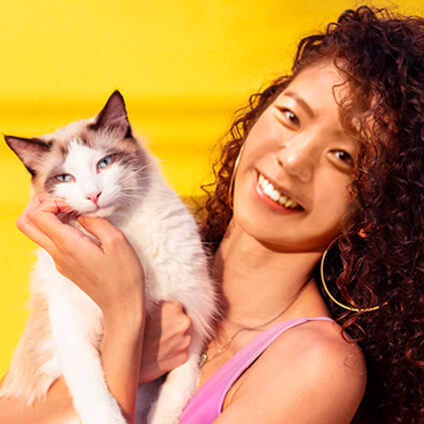
With over five years of specialized experience as an animal writer, my expertise lies in cat nutrition, health, behavior, grooming, and training. I am dedicated to delivering helpful and informative content that caters to the well-being of our feline friends. My primary goal is to empower pet owners with knowledge and ensure our feline companions thrive in health and happiness. In my free time, I love volunteering at local cat rescue centers.
